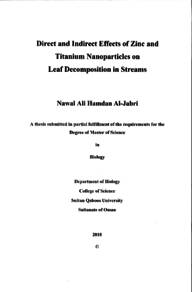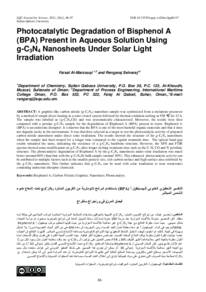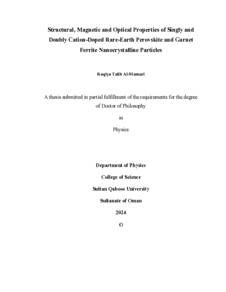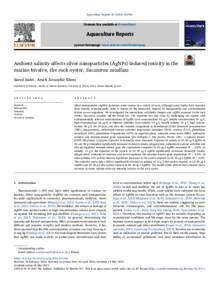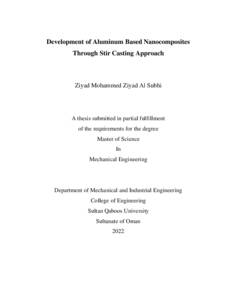Document
Direct and indirect effects of zinc and titanium nanoparticles on leaf decomposition in streams
Publisher
Sultan Qaboos University
Gregorian
2018
Language
English
English abstract
Abstract Nanoparticles are used in many commercial products and can eventually migrate into freshwater ecosystems where they can cause toxic effects either directly or indirectly to ecosystem processes. The aims of this study were to measure the effects of ZnO and TiO2 nanoparticles (NPs) alone and in combination on leaf litter decomposition of Ficus sycomorus in freshwater streams in Oman and to measure their effect on microbial counts, microbial community metabolism, on bacterial community composition and extracellular enzymes. In experiment 1, ZnO and TiO2 NPs alone and in combination (0, 1, 10, 100 mg/L) were used to study their effect on leaf decomposition during three incubation periods (2, 4, 6 weeks). Percentage of mass loss, respiration rate, microbial (bacteria and fungi) counts and B-glucosidase activity were measured. TiO2-NPs alone had the strongest effect, causing reduced of mass loss. Respiration rate increased in ZnO-NPs and in combination solution. There was no significant effect of the NPs on chlorophyll a. There were a significant declined in bacterial number in exposure to Zn-1mg/L and Ti-1 mg/L after 6 weeks of incubation. On the other hand, the combined solution showed no significant effect on bacterial counts. There was higher bacterial diversity at 10 mg/L of all NPs and in the combined solution, which had inhibitory effect in which it was equal to the sum of each NPs. Nitrospira was the dominant genera in controls and decreased with different NPs concentrations. There were 18 genera, 10 classes in all treatments. Alphaproteobacteria, Gammaproteobacteria, Betaproteobacteria and Bacilli were the most dominant classes. Experiment 2 measured the effects of light and bacteria on decomposition. ZnO and Tio NPs alone and in combination at a concentration of 10 mg/L were added to two set of containers, one exposed to the light and the other set covered with black cardboard to provide dark condition. An antibiotic (Chloramphenicol 10 ug) was added to half the treatments. The aim of this part was to differentiate the direct effects of NPs on microbes from effects of light-generated ROS directly on leaf litter decomposition. There was a significant effect of NPs, light and antibiotics on the leaf mass loss. The mass loss in darkantibiotic was higher than light-antibiotic. While, bacterial number in light-non-antibiotic was higher than light-antibiotic except in TiO2 NPs. Also, bacterial number in dark-nonantibiotic were higher than in dark-antibiotic in all NPs treatments. The elements analyzer showed %>N%>H% under all treatments and in dark greater than light. In Experiment 3, leaf discs were exposed to NPs at 10 mg/L with antibiotics in light and dark. ZnO-NPs inhibited mass loss in light only. While there were significantly inhibition on mass loss in TiO-NPs and (Zn+Ti)-NPs in light and dark conditions. The result showed that nanoparticles in aquatic environments can affect leaf litter decomposition directly and indirectly. Further research needed to investigate the effect of these NPs alone and in combination on their behavior against microbial decomposer under different conditions.
Description
Thesis
Member of
Resource URL
Arabic abstract
تستخدم كثير من المنتجات التجارية الجزيئات النانويه في مكوناتها والتي لها تأير سمي سواء أكان بطريقة مباشره او غير مباشرة، تهدف هذه الدراسة إلى قياس تثير الجزيئات الناتويه من أكسيد الزنك وثاني أكسيد التيتانيوم إما بمفردها وإما بالدمج بينهما على عملية تحلل أوراق الشجر التين Ficus syOrtorts في المياه العثية كما تهدف إلى قياس تأثير الجزيئات النانونه على كل من : أعداد الكائنات الدقيقة، عمليات الأيض للمجتمعات الميكروبية، وتركيب المجتمعات البكتيريه والانزيم خارج الخليةفي التجربة الأولى، تم استخدام الجزيئات الثانويه من أكاسيد الزنك والتيتانيوم إما بمفردها و إما بالدمج بينها بأربع تراكيز مختلفة (0، 1، 10، 100 ملغ /لتر) لدراسة تأثيرها على تحلل أوراق الشجر خلال ثلاث فترات زمنيةأسبوعين أربعة أسابيع وستة أسابيع)، بعد ذلك تم قياس نسبة فقدان كتلة الأوراق و الكتلة الحيوية البكتيرية ومعدل التنفس ونشاط انزيم قد جلوگو سایدیز، و في النتائج، لم يكن هناك تأثير الأكسيد الزنك-NPs و خليط أكسيد الزنك والتيتانيوم-NPs على فقدان كتلة الأوراق بينما ثاني أكسيد التيتانيوم-NPs كان الأقوى تأثيرا من حيث سبب انخفاضا كبيرا في فقدان كتلة الأوراق. كما زاد معدل التنفس في العينات المعرضة إلى أكسيد الزنك - NPs و الدمج بين أكسيد الزنك والتتيانيوم -NPs لم يكن هناك أي تأثير للجزينات النانويه على كلوروفيل (أ) و أعداد الفطريات خلال فترات الحضانة المختلفة. بينما كان هناك انخفاضا في أعداد البكتيريا المعرضة للتراكيز المنخفضة من أكسيد الزنك و التيتانيوم (1 ملغ /لتر) بعد حضانة ستة أسابيع، ولكن لم يكن هنالك تأثير لدمج هذا النوعين من الأكسيد على أعداد البكتيريا كان هناك تنوع بكتيري كبير في كل العينات خلال فترات الحضانة. وكانت البكتيريا التابعة لجنس Nitro spoir هي السائدة في التركيز صفر-NPs وتقل كلما زاد التركيز من الجزيئات الناتونه. كان هنالك تقريبا 18 جنسا و 10 صفوف من البكتيريا في مختلف عينات الدراسة وكانت الصفوف التالية هي الأكثر شيوعا, Betaproteobacteria , Gammaproteobacteria , Alphaproteobacteria.Bacillisفي التجربة الثانية، أعدت مجموعتين من الحاويات، مجموعة واحدة تعرضت للضوء والمجموعة الثانية مغطاة بورقة سوداء للحفاظ على حالة الظلام، كما تم اضافة 10 ملغ /لتر من أكسيد الزنك وثاني أكسيد التيتانيوم إما بمفردها أو يدمجها مع بعض إلى الحاويات لمدة أسبوعين. تم اضافه أقراص المضادات الحيوية (كلوروامفينكول ذات التركيز 10 ميكروجرام) إلى بعض الحاويات. تهدف هذه التجربة إلى التمييز بين تأثير الجزيئات الناتويه من تأثير ROS مباشرة على تحلل الأوراق. وفقا لصور المجهر الإلكتروني الانتقالي (TEM) فإن حجم ثاني أكسيد التيتانيوم كان تقریبا 120 نانو متر بينما كان قياس حجم أكسيد الزنك - NPs يترواح ما بين 20 إلى 30 نانومتر وهو قياس قریب إلى حجمه تجاريا. كما أظهرت صور المسح المجهري الإلكتروني لأقراص الأوراق بتعرضها لتلف كبير في تراكيب الورقة مثل إزالة كلا من الشعيرات الصغيرة وطبقات البشرة والأحزمة الوعائية. كما تم التوصل إلى أن معدل فقدان الأوراق في الظلام وبوجود المضادات الحيوية كان أعلى من النهار وبوجود المضادات الحيوية كما كانت أعدد البكتيريا في الظلام بدون المضادات الحيوية أعلى الظلام بوجود المضادات الحيوية كما أظهر جهاز المحلل العنصري إلى أن نسبة الكربون أعلى من النيتروجين والتي بدورها أعلى من الهيدروجين في كل العينات وفي الظلام أعلى من النهار في التجربة الثالثة، كان التعرض إلى أكسيد الزنك. NPs بالظلام قد سبب انخفاضا كبيرا في معدل فقدان الأوراق بينما كان هنالك انخفاضا كبيرا في معدل فقدان الأوراق لكلا من ثاني أكسد التيتانيوم إلى خليط أكاسيد الزنك والتيتانيوم في الظلام والنهار على حد سواء. هنالك حاجة ملحة إلى مزيد من الدراسات للتحقق من تاثير سمية الجزيئات النانوية سواء بمفردها أو عند خلطها مع انواع مختلفة على سلوكها مع بعضها وعلى الكائنات الدقيقة المحللة في مختلف الظروف
Category
Theses and Dissertations

